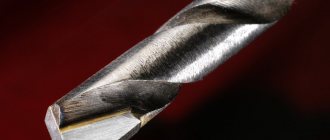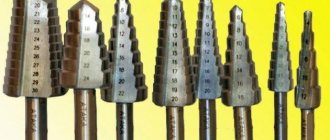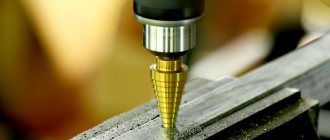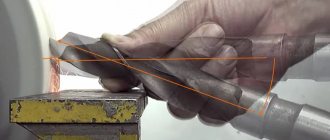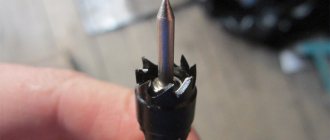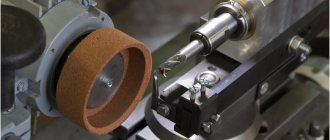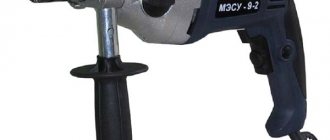Step drills are metal-cutting tools designed for working with thin sheet metal. The products are made in the form of a cone and have sharpened steps of a certain diameter. The product is suitable for manual and mechanized operation and significantly simplifies the work of the master.
In the material:
- In what cases is drill sharpening required?
- What drills can be sharpened?
- How to sharpen a step drill for metal? How to sharpen a step drill with a file?
- How to sharpen a tapered step drill for metal using a drill
- How to sharpen a step drill for metal using a grinder wheel?
Which step drills for metal are best to choose?
To make a high-quality hole in metal, you need to select a drill that will cope with this task. If you need to perform high-precision work in sheet material up to 4 mm thick, then a step drill for metal will be most suitable for this. Such cutting products not only have increased accuracy, but also require the correct approach to the drilling operation.
To process the material correctly, you need to know some of the nuances of selecting and using such a tool. All the intricacies of metal processing using cone drills will be discussed in detail below.
Types of sharpening
Some types of sharpening have already been mentioned above, but we will repeat it again. So, there are five types of sharpening, which are selected based on the type of material and the specifics of the work associated with drilling.
The first of them is normal under the title “N”. This variety is universal, but is used only if it is necessary to sharpen a drill with a diameter of no more than 12 mm. Essentially, two cutting edges and one transverse edge are formed on the tool. To do this, you have to maintain an angle within 118-120°.
And the rest:
- NP – sharpening is done with a short crossbar to reduce the load on it;
- NPL - in addition to the transverse edge, the width of the ribbon is also reduced, the goal is to reduce the friction force that is created between the drill and the workpiece;
- DP is the so-called double sharpening, where in addition to the transverse edge, four more edges are formed, which are broken lines;
- DPL is the same previous version, only the ribbon is additionally sharpened.
Attention! Why are four edges needed? This is an opportunity to reduce the angle between sections of the peripheral planes of the edges. Thus, an increase in heat removal from the drilling site is achieved. And this increases the service life of the tool itself.
Correctly carried out sharpening of a drill Source tehnomuza.ru
How to sharpen a step drill with your own hands
Long-term use of a gimlet causes it to become dull. This makes it necessary to have information on how to sharpen it correctly. Although this is not an easy procedure, if you have reliable information and skills, everything will work out.
The procedure for sharpening a cone drill requires the following sequence of actions:
- secure the gimlet with a vice;
- install a grinding wheel on the grinder;
- Being careful, sharpen the cutting edges that have been damaged.
There are several options for sharpening a step drill. For example:
- Single-plane. This type of sharpening is used to sharpen tools whose thickness does not exceed 3 mm. During the sharpening process, it is recommended to attach the tool to the sharpening wheel, moving the gimlet along the wheel. It is worth noting that using this type of sharpening may cause slight damage to the cutting edge of the drill.
- Conical. Recommended for sharpening gimlets with a length of 3 mm or more. While working, it is recommended to lightly press the drill onto the circle and carefully move it along the work surface.
- Finishing. Used to correct small errors and inaccuracies that have arisen after sharpening. For work you should take a soft sharpening stone.
Sharpening step drills yourself requires excellent lighting, vision and accuracy.
Can step drills and countersinks be sharpened by hand?
Hello, dear forum users. Actually, the question is included in the title of the topic: is it possible to sharpen step drills, simply carrots, as well as countersinks that have a similar shape, manually, efficiently, without losing the geometry of the tool?
Or is it a disposable cutting tool, it got dull and was thrown away.
What do you think?
look for someone who has a normal sharpening machine with accessories. Let's just say that they were somehow sharpened during production. They will undermine it in the same way. Definitely don't let sharpeners use the sharpener.
*Boston* wrote: Definitely don't give it to sharpeners.
Yes, I myself like to sit with the abrasive, but here, frankly, I’m in a difficult situation. Correct the cutting edge on a diamond? (with the edge of a standard circle you can’t get close), sharpen (lower) the radii of the backs of the heads? Already a violation of geometry. In general, while it’s foggy
It seems to me that it is more profitable to buy several pieces, and then give them to sharpen the same way. So that there are no extra tears about changing the equipment on the grinding machine
What if at an angle of 45 by rotating the countersink itself (for example, on a flat diamond block)? In theory, RK should be imprisoned. Doesn’t it stick out beyond the dimensions of the cone on the new one?
Andrew Nik, how to do the backing?
In principle, for three-blade countersinks, it will probably be most convenient to shoot along a plane. I figured the Spyderco Triangle Sharpmaker rods would fit into this cutout. They also come in diamonds.
Andrew Nik wrote: triangular rods from Spyderco Triangle Sharpmaker
Thank you. An interesting option, but how budget-friendly? In principle, it’s the same on a diamond cup. But this is only the first stage of sharpening, the backing must also be done somehow. I will think.
taels wrote: Or is it a disposable cutting tool, got dull and threw it away. What do you think?
Obviously you are not a toolmaker
Do you think the tap can be sharpened by hand, the answer is easy [
Design and characteristics of a cone-step drill
These instruments have a rather complex design. Their configuration may differ depending on the variety. Let us consider in more detail what parts such products consist of. The top of the drill is represented by a pointed tip, which makes it possible to cut into metal of any density without much difficulty.
Other tools are also used for processing metal sheets, for example, crown tools. A metal drill of this type does not require the use of auxiliary centering devices, but it is not suitable for working with thin metal. Spiral analogues also do not allow such work to be performed accurately.
Step products are very effective when working with aluminum, steel, copper and other sheets and pipes. Tools of this type are shaped like a cone, which includes 2 grooves. They promote drilling of materials. During operation, when moving to the next level, a chamfer is formed for the hole that is created by the previous step.
Due to their design, step drills are suitable for working with copper, steel and aluminum sheets
A 4-32 mm step drill for metal also has an opposite end, which is mounted in the tool chuck. The opposite end, or tail, has the most suitable design for this and consists of six edges. The advantages of such tools are undeniable, which is why many craftsmen recommend them for working with metal parts.
Features and benefits of using cone drills
The cutting edges of the stepped device have a high strength index, which ensures a long working life.
Unlike conventional metal drills, a step tool allows you to perform a number of jobs that would otherwise require the use of a litany of other tools.
It is precisely because of this versatility that the price of step drills is too high.
The second advantage of using a drilling product is the drilling speed, at which the quality of the edge is not reduced even for thin sheet metal.
In addition to metal, using conical devices, you can work with drywall, wood, plastic and other materials.
Dense metal is also not a problem that a step drill can't handle.
Its sharp tip easily cuts into a metal product with the densest structure. In this case, there is no need to use a centering element, which simplifies the working action.
The unique design of conical products makes it possible to eliminate the use of an angle grinder and a needle file, and, if necessary, polish the finished hole.
The translational channels of the device differ in size and have a smooth transition of 35-450, which in turn increases the efficiency of drilling work with thin metal by 50%.
IMPORTANT TO KNOW: Operation of CNC milling machines for metal
In addition, their design helps to enhance the cutting properties of the tool and at the same time ensures its smooth operation when processing metal.
This attachment can be used for both automated and manual devices.
The abrasive coating gives the cone product special strength.
It can be made of diamond or titanium chips, thanks to which there is no need to frequently sharpen the product under normal load conditions.
Video:
The price of cone drills for metal depends on the diameter of their working part and the type of spraying; at the moment it can range from 2 thousand to 5 thousand rubles.
The easiest way to solve the problem of “ragged” holes, which can have different configurations, is to use a step metal drill.
With the correct diameter of the tool, you can improve any unsuccessful attempt to make a hole.
In addition, a cone drill is indispensable when working with thin sheet metal, fiberglass and plastic products.
Therefore, a step drill can be called a device “for all occasions”; it is good to have for specialists in various workshops, installers and home craftsmen.
In our video you can see how to use this tool.
Advantages of cone drills
Stepped products have the following positive properties:
- allow you to make a hole with smoother edges compared to spiral and feather counterparts;
- For holes of different diameters, one step drill is used;
- perfectly centers the hole;
- used for processing very thin sheet metal;
- ideal for processing non-ferrous metals;
- for large volumes of work, it saves time due to the absence of the need to frequently replace drills of different diameters.
A step drill allows you not only to perform high-quality drilling of metals, but also to correct hole defects that were made with other types of products. For example, if the center of the hole is displaced when using spiral analogues, a conical one can completely correct the defect.
It is also possible to expand the holes if necessary to a fixed diameter. Despite the higher cost of cone drills, significant savings can be achieved with frequent use. Due to the absence of the need to purchase a large number of tools of different diameters.
A cone drill allows you to chamfer during drilling and therefore does not require additional time, which saves time during large volumes of work.
Checking the sharpness of the drill
After a visual inspection shows that the cutting edges are smooth and sharp, check whether the correct sharpening angle of the metal drill is maintained and whether the length of the working edges meets the standards. To evaluate, you will need a special template, a protractor or protractor, and a caliper.
Checking the length of the cutting edges with a caliper
What parameters need to be checked?
- Is the angle of the cutting edge tilted forward? The presence of such an error makes the cutting edge not the highest point of the tooth and forms a hill on the back surface. This causes the drill bit to rub against the back surface of the material and not drill. The error is corrected by sharpening the drill again.
- Are the lengths of the cutting edges consistent from the center point on the web to the side apexes of the cutting edges? This distance must be the same on both sides, otherwise the diameter of the final hole will be larger than the nominal value.
- Check that the apex angle is 120°. You can determine the sharpening angle of a metal drill using a purchased or homemade template. It is important to ensure that the apex angles match for both teeth, otherwise only one side will work.
Correct and incorrect sharpening of a drill
After checking the basic parameters, drill into any metal workpiece. If the sharpening is done correctly, the drill will smoothly enter the metal, and the chips will evenly exit the grooves on both sides. And the finished hole will exceed the nominal diameter by no more than 0.05–0.1 cm.
After drilling the workpiece, sharpen the jumper to reduce the force applied during operation and reduce tool wear.
How to make a template for checking drill sharpness?
A template for checking the sharpening of a metal drill can be made independently from sheet steel or tin. You can take a template from the store as a guide. The simplest template can be made from two or three nuts. Nuts are ideal for these purposes, as they are regular hexagons with internal angles of 120°. If the nuts are connected, the angle between their faces will also be 120°. The nuts can be welded or glued to each other using hot glue.
see also
Comments 131
You can correct it on a diamond wheel if your hands don’t shake :-). Carefully follow the groove along the drill, but I don’t think it will work by hand, because... The hardness of the drill is equal to the hardness of the nail file, and I have never seen diamond files.
A diamond file will sharpen any drill... Take a triangular one and just slightly adjust the edge...
As an option! Thank you
Just use a stone under the cutting edge, carefully adjust it and that’s it!
order on Ali for 120 rubles, I ordered these www.aliexpress.com/snapsh…ml?order >
It has many purposes, starting from drilling. Another plus is that one cone replaces a large number of drills.
So does it just replace a lot of drills or is it famous for something else?
drills the tin evenly,
There is a lot described below
It's called a reamer... you drill a hole and then expand it...
Scanning is something completely different! This is exactly the drill! It drills itself, the initial hole is 6mm or more
On the front surface.
With a diamond file, I corrected it a hundred times.
All that remains is to remember “Crazy Hands” and crafts made from a plastic bottle...
I sharpened on a diamond wheel. But not everything is simple there. The opposite side, especially after sharpening, does not allow the cutter to reach the circle. Therefore, I rounded this cutter into an oval on the sharpener, so that the cutting edge was higher than the opposite one, and then restored the sharpness on the wheel. It cuts nothing like that.
Well, it’s not the price of space, buy a new one... to sharpen it at home will be either pathetic or completely crap...
+1 especially since you can buy a small cone that is just up to 8-12mm
Well, it’s not the price of space, buy a new one... to sharpen it at home will be either pathetic or completely crap...
I don’t know about you, we have it for $27, I saw it and didn’t want to buy it, I looked on Aliexpress ru.aliexpress.com/item/He…01644_5,searchweb201560_8, it’s much cheaper there, but you don’t know what they’ll send.
I found here for $40)))
Probably depends on the impudence of the hucksters))
I found here for $40)))
and we’ve seen up to $100)))
That's about the same thing I took
I don’t know about you, we have it for $27, I saw it and didn’t want to buy it, I looked on Aliexpress ru.aliexpress.com/item/He…01644_5,searchweb201560_8, it’s much cheaper there, but you don’t know what they’ll send.
I bought a normal one, everything comes. I bought it for the first time in my general store for 600 rubles. It worked hard and died. I had to drill 20 mm holes in 2.5 mm thick galvanized steel, 400 pieces. I ordered a set of 3 different ones from the Chinese for 340 rubles. It’s called feel the difference))
I don’t know about you, we have it for $27, I saw it and didn’t want to buy it, I looked on Aliexpress ru.aliexpress.com/item/He…01644_5,searchweb201560_8, it’s much cheaper there, but you don’t know what they’ll send.
I often use it for work, so I bought it on Ali seven times, maybe more. All from different sellers, sets of three and individually, of different diameters, with a round shank and a hex adapter. Everything is five times cheaper or more than in stores, the quality is always better than store-bought ones, no matter what brand, the coating is titanium nitride (yellow), high-speed steel (which one is unknown) holds up well, here are a couple of sets offhand: ( ru.aliexpress. com/item/1s…01644_5,searchweb201560_8) (ru.aliexpress.com/item/3P…01644_5,searchweb201560_8)
I don’t know about you, we have it for $27, I saw it and didn’t want to buy it, I looked on Aliexpress ru.aliexpress.com/item/He…01644_5,searchweb201560_8, it’s much cheaper there, but you don’t know what they’ll send.
Recently I bought one for myself with Ali. The price is about six imported, the quality is excellent, but the wait is about a month.
I don’t know about you, we have it for $27, I saw it and didn’t want to buy it, I looked on Aliexpress ru.aliexpress.com/item/He…01644_5,searchweb201560_8, it’s much cheaper there, but you don’t know what they’ll send.
Haven’t I tried to read customer reviews about the product, or have I just discovered a great secret for someone?)))))
And what's in the reviews? They are usually positive, what do they write more specifically?
You take your shoes off, turn on your brain, look at the seller’s rating, and analyze what they write about a specific product. No normal person will write a good review if the product is crap. But if a potential buyer fails to spend an extra few minutes reading, then such deer will then write that everyone around is assholes, and that they, the noble D'Artagnans, have been sold a piece of crap by the bad Chinese... What, again a discovery for someone? )))
If you spend a few minutes and read the comments below, you can understand that I didn’t get it from eBay! And for everyone the word “good” means completely different things! For some, the Tavria is a good car, for others, only a Mercedes is a good car, and for others, a Volkswagen is a good car, because it breaks down not much more often than a Mercedes, to each his own!
I see no point in continuing this pointless dialogue. You need a branded tool, you choke a toad and buy it, or you take a pack of Chinese ones for the same money and use it calmly... Well, jerking off with a sharpening is masturbation IMHO))))
Well, it’s not the price of space, buy a new one... to sharpen it at home will be either pathetic or completely crap...
exactly this - you can say space, I bought it for about 100, many years ago, this is not bullshit or anything, but a professional instrument!
Better throw it away right away! than with an angle grinder! such things are crazy with an angle grinder! at least a Chinese sharpening machine where you can fix and accurately set sharpening angles. . By the way, if you get one like this, you won’t lose anything, you’ll just gain. many tools will be ok
using a grinder) or whatever) you attach it in a vice and off you go) or better yet with diamond burs
Manufacturers of step drills
Products made in China are of low quality (there are exceptions). To buy a good cone drill, you should pay attention to tools made in Europe and Russia.
1. “Zubr” - stepped drills from a domestic manufacturer are of reasonable cost. The quality is at a fairly high level.
Cone drills can be made from ordinary tool steel or coated with more wear-resistant alloys. In the latter case, the price will be significantly higher, but the quality of the cutting surface will remain sharp longer even when performing a large volume of work.
2. “Attack” - Russian-made conical drills, which in quality and cost are not inferior to the best products from foreign companies.
Reviews about the products of this company are only positive, so you don’t have to worry about the quality, and in order not to overpay, you should select a tool taking into account the maximum diameter that will be needed in the work.
3. “Bosch” - the products of this German company are excellent for professionals and for working with metal at home.
The diameters on the tool are marked using a laser system, so in case of long-term use, the inscriptions are not erased. To increase the drilling speed, the top of the Bosch step drill is sharpened crosswise, and the workpiece is ground in both the transverse and radial directions.
Such processing of the tool allows, when using it, to obtain a high-quality hole, the diameter of which will fully correspond to the stage of the product.
4. “Falon-Tech” - drills from a German company have an additional titanium coating, which allows you to increase the tool life by more than 2 times.
The product has a laser marked diameter and a standard shank that is ideal for use with a screwdriver or hand drill.
Despite the increased quality of the product, its cost remains low. If you need to purchase a cone drill for home use, then the choice of products from this company is the most optimal.
All of these cutting tools do an excellent job of drilling metal up to 4 mm thick. If you need to work with thicker metal, it is recommended to use core drills.
Advantages and disadvantages of stepped design
Multi-stage metal drills are classified as a separate subcategory. If the working surface of a cone drill can only be formed by a straight groove, then the multi-stage design allows both straight and spiral translational grooves. The former are easier to sharpen at home, while the latter ensure smooth operation when drilling.
Fixed step diameters make it easier to understand the size of the drilled section. Most models have a step of 2 mm, while the height of the steps varies between cutters. Smooth transitions remove burrs and increase the efficiency of drilling thin-walled metal by 50 percent or more. Thanks to the stepped geometry, the hole is chamfered simultaneously with the hole.
Unlike conical nozzles, stepped nozzles are suitable for working with metal up to 4 mm thick. Other disadvantages include the need to use machines and drills with low rotation speeds (up to 1000 rpm) and high torque, as well as increased sensitivity to distortions that occur during drilling.
How to drill correctly
If you have a sharp tool, you can drill a hole in a metal workpiece no more than 4 mm thick. For proper operation, it is recommended to follow the following sequence of actions:
- Mark the location where the hole needs to be drilled using a core.
- During drilling, the tool must be held perpendicular to the working surface of the metal workpiece.
- The grinder (screwdriver) should operate at low speeds. Their value depends on the diameter: with increasing diameter, the rotation speed of the tool decreases.
- As a result of drilling, the operating temperature of the working surface increases. To reduce it, it is recommended to use a thin layer of oil to lubricate the tool.
Violation of the operating procedure can lead to its rapid dulling.
It is important not only to adhere to the recommendations for using the tool, but also to choose it correctly. The quality of a drill largely depends on the color of the metal from which it is made. For example:
- Steel with a hint of grey. This indicates that the finished tool has not been subjected to heat treatment. Such a gimlet will not last long.
- Black. After manufacturing, the drill was processed using hot steam. Thanks to this, the strength of the metal also increases.
- Golden. This color of the gimlet means that the metal is free from tension. This increases its quality and strength.
- Bright golden. This color indicates a high level of wear resistance. When creating such a tool, a metal containing titanium nitride impurities is used. They are characterized by high cost and long service life.
With proper use and selection of a stepped gimlet, the tool will serve correctly and for a long time.
Selecting a cone drill
The ability to read markings is a key skill for all craftsmen, and conical drills are no exception. The marking indicates the diameters of the holes that the nozzle can make, the step pitch and the length of the product. It also provides information about the metal from which the device is made. For example, the marking Ø4−12/2 HRC 61±2 should be interpreted as follows:
- Ø4 - initial diameter;
- Ø12 - final diameter;
- 2 — pitch of step drill diameters (with the given parameters, it is possible to make holes Ø4, Ø6, Ø8, Ø10, Ø12);
- HRC - steel grade (in the example this is high-quality high-speed steel);
- 61±2 - Rockwell hardness.
Pay attention to the length of individual steps and/or the total length of the working surface. The type of shank plays an important role - the compatibility of the cutter with drilling equipment depends on it. Shanks can be cylindrical, conical or hexagonal.
Cone drills are made from more than forty different grades of steel. The average consumer does not need to understand all the differences between them; it is easier to remember the abbreviation HSS. Its presence means that the drill can be used in high-speed processing, and during intense heating it will not deform or lose its strength characteristics.
Having decided on the geometric parameters and material of the nozzle, they look at its color. And this is not a matter of aesthetics, since the color determines what additional processing the product has undergone at the factory:
- The surface of a bright golden color indicates the presence of an abrasive coating, usually titanium nitride (TiN, AlTiN). Spraying significantly extends the service life of the drill (by 25 and 50 percent, respectively), but you will have to pay for increased wear resistance.
- Golden color means that the metal is free from internal stress.
- The black tool is treated with steam, its strength is increased.
- Gray-steel cutters are not subjected to additional processing; other things being equal, their service life and performance characteristics are inferior to the first three types.
Characteristics of brands
You should purchase products from trusted stores, giving preference to well-known brands. The quality of steel in cheap no-name drills may not correspond to reality, and dubious stores often sell banal counterfeits at an inflated price. Recommended brands for purchase:
- German: Falon Tech, Karnasch, Ruko, Topcraft;
- Polish: Geko;
- Russian: Attack, Globus;
- Ukrainian: Lezo, Zubr.
Thanks to careful quality control in European factories, Polish and German tools are more efficient and durable, although they are more expensive. Drills from the countries of the former USSR are a compromise between price and quality, but when choosing them you need to make sure that the quality of the metal complies with GOST. It is recommended to refrain from purchasing suspiciously cheap Chinese products.
How to extend the life of a drill
To ensure less wear on the drill, you must follow some operating rules.
- Do not overheat the drill. To do this, work at intervals and use coolant.
- Set the correct rotation speed. It is set taking into account the type and diameter of the drill, as well as the material.
- Remove the chips. Periodically remove the drill from the hole and remove the chips so that it does not get stuck in the workpiece.
- Drill holes in several approaches. If you need to make a hole with a diameter of more than 6 mm, use drills of different sizes (from larger to smaller), this will guarantee higher accuracy.
Which step drills for metal are best to choose?
To make a high-quality hole in metal, you need to select a drill that will cope with this task. If you need to perform high-precision work in sheet material up to 4 mm thick, then a step drill for metal will be most suitable for this. Such cutting products not only have increased accuracy, but also require the correct approach to the drilling operation.
To process the material correctly, you need to know some of the nuances of selecting and using such a tool. All the intricacies of metal processing using cone drills will be discussed in detail below.
Self-sharpening
Only the cutting edge (groove) is sharpened.
It is prohibited to sharpen the transitions of step drills, as this leads to a change in the geometry of the working surface and the formation of burrs during operation. Improper sharpening leads to a decrease in the quality of the tool, often to complete disrepair. The long service life of conical drills requires periodic re-sharpening. At home, drills with a straight translational groove are the easiest to use. This is done manually using abrasive rods, diamond stones for knives or sandpaper.
Any home craftsman needs to know how to sharpen a step drill for metal with a spiral flute. The process requires the use of sharpening machines, on which the drill is directed so that the abrasive wheel passes exclusively in a spiral. For simultaneous smooth rotation, special devices are used; feeding the drill manually is highly not recommended.
Sources
- https://pressadv.ru/metally/kak-zatochit-stupenchatoe-sverlo.html
- https://TehnoPanorama.ru/instrumenty/stupenchatoe-sverlo-kak-zatochit-i-pravilno-sverlit.html
- https://gazsnabstroy.ru/prochee/kak-zatochit-stupenchatoe-sverlo-po-metallu
- https://steelfactoryrus.com/kak-zatochit-konusnoe-stupenchatoe-sverlo/
- https://ooo-asteko.ru/kak-zatochit-stupenchatoe-sverlo-po-metallu/
- https://remoskop.ru/stupenchatyie-i-konusnyie-svyorla-po-metallu-ekspluatatsiya-i-zatochka.html
- https://SdelaySam-SvoimiRukami.ru/7469-3-sposoba-zatochit-stupenchatoe-sverlo-v-domashnih-uslovijah.html
- https://master-pmg.ru/raboty-po-metallu/kak-zatochit-stupenchatoe-sverlo.html
- https://generator98.ru/metally/kak-zatochit-konusnoe-stupenchatoe-sverlo.html
Sharpening accessories
It is difficult for beginners to carry out the sharpening procedure efficiently. Therefore, manufacturers of construction tools have been producing special attachments for drills for a long time. This is actually a nozzle. It must be installed on a drill, insert a drill into the hole from the end and turn on the power tool.
Then the drill is pulled out, rotated 180°, reinserted into the drill sharpener, and the drill is turned on again. That is, the second plane of the cutting edge is sharpened.
Device for sharpening a drill mounted on a drill Source yandex.net

